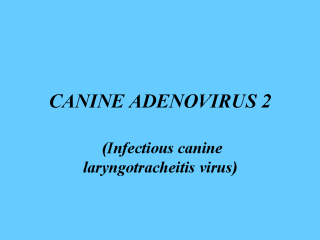Virus:
Some antigens are shared between the CAV 1 and 2 by VN. Pathogenesis and clinical
signs:
CAV 2 causes necrosis of the respiratory tract. It is characterised by fever, mild
depression and nasal or ocular discharges; corneal opacity is sometimes seen. Animals
develop a dry, harsh and persistent cough, with some signs of pneumonia but no
hepatitis. Lung lesions may be exacerbated by concurrent bacterial proliferation, e.g.
B.bronchiseptica, P.multocida, Streptococci.
Immunity and epidemiology:
Infection spreads readily between unvaccinated dogs, e.g. in stray dog kennels via direct
and indirect contact.
Diagnosis:
Virus isolation from respiratory secretions early on in the disease.
Control:
Cross-protection via CAV 1 vaccines. Subcutaneous or intranasal vaccination by
tissue-culture attenuated CAV 2 is possible but occasionally results in blue-eye.
Isolation of coughing dogs. Disinfection of premises.
